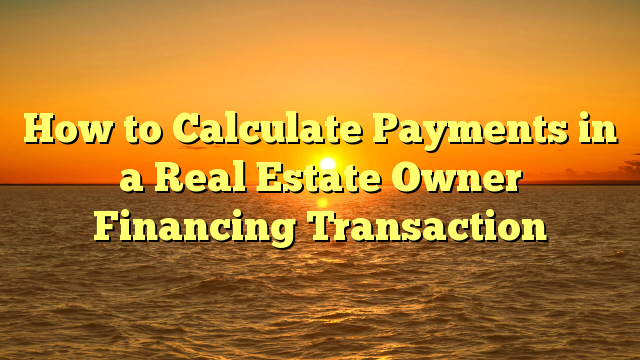How to Calculate Payments in a Real Estate Owner Financing Transaction
If you’re considering buying or selling a property, you may have come across the term “owner financing.” This is a popular way for real estate transactions to take place where the seller acts as a lender and finances the purchase for the buyer. In owner financing, the buyer agrees to make regular payments to the seller, which includes both principal and interest. But how do you calculate these payments? In this article, we’ll take a closer look at how to calculate payments in a real estate owner financing transaction.
Understanding the basics of owner financing
Before we dive into calculating payments, let’s first understand the basics of owner financing. In this type of transaction, the seller finances the purchase for the buyer, which means the buyer does not need to secure a traditional loan from a bank or financial institution. Instead, the buyer makes regular payments to the seller until the property is paid off in full.
Owner financing can be beneficial for both the buyer and seller. For the buyer, it can be easier to secure financing and they may be able to negotiate better terms than they would with a traditional loan. For the seller, they may be able to sell their property more quickly and earn a steady stream of income from the payments.
Calculating the loan amount
The first step in calculating payments is to determine the loan amount. This is the amount of money the seller will finance for the buyer. To determine the loan amount, the seller will typically look at the purchase price of the property and subtract any down payment or other fees.
For example, let’s say the purchase price of the property is $200,000 and the buyer is putting down a $20,000 down payment. The loan amount would be $180,000.
Determining the interest rate
The next step is to determine the interest rate. This is the amount of money the buyer will pay in interest on top of the loan amount. The interest rate can be negotiated between the buyer and seller, but it’s important to keep in mind that it should be reasonable and competitive with current market rates.
Once the interest rate is determined, it’s expressed as an annual percentage rate (APR). For example, if the interest rate is 5%, the APR would be 5% per year.
Choosing the loan term
The loan term is the amount of time the buyer has to pay back the loan in full. This is typically expressed in months or years. The loan term can be negotiated between the buyer and seller, but it’s important to keep in mind that a longer loan term means more interest paid over time.
Calculating the payment amount
Once the loan amount, interest rate, and loan term are determined, you can calculate the payment amount using a loan amortization calculator or spreadsheet. This will give you a breakdown of each payment, including how much is going toward principal and how much is going toward interest.
It’s important to note that payments may change over time, especially if the interest rate is adjustable or if there is a balloon payment at the end of the loan term. It’s important to discuss these details with a real estate attorney or financial professional before entering into an owner financing agreement.
Conclusion
Owner financing can be a great option for both buyers and sellers in a real estate transaction. However, it’s important to understand how to calculate payments and negotiate reasonable terms to ensure a successful transaction. By following the steps outlined in this article, you can calculate payments and make informed decisions about owner financing.
FAQs
- Can the interest rate be changed over time in an owner financing agreement?
Yes, the interest rate can be adjustable or fixed depending on the terms of the agreement.
- What happens if the buyer defaults on payments in an owner financing agreement?
If the buyer defaults on payments, the seller may have the right to foreclose on the property and take possession of it. It’s important for both parties to clearly outline the consequences of default in the owner financing agreement.
- Can the buyer pay off the loan early in an owner financing agreement?
Yes, the buyer can typically pay off the loan early, but it’s important to review the terms of the agreement to determine if there are any prepayment penalties.
- Can owner financing be used for commercial properties?
Yes, owner financing can be used for both residential and commercial properties.
- Do I need a real estate attorney to assist with an owner financing agreement?
It’s highly recommended to consult with a real estate attorney or financial professional before entering into an owner financing agreement to ensure all terms and conditions are clearly outlined and legal requirements are met.
- Is owner financing a good option for buyers with poor credit?
Owner financing can be a good option for buyers with poor credit who may have difficulty securing a traditional loan from a bank. However, the terms of the owner financing agreement may include a higher interest rate or more stringent requirements to compensate for the higher risk.
- How do I determine if owner financing is the right option for me?
Before deciding on owner financing, it’s important to consider all your options and consult with a financial professional or real estate attorney. Owner financing may be a good option if you’re having difficulty securing a traditional loan or if you’re looking for more flexible terms. However, it’s important to carefully review the terms of the agreement to ensure they are reasonable and in your best interest.
- Can I negotiate the terms of an owner financing agreement?
Yes, the terms of an owner financing agreement can be negotiated between the buyer and seller. It’s important to clearly communicate your needs and priorities to ensure a successful transaction.
- What are some common pitfalls to avoid in an owner financing agreement?
Common pitfalls to avoid include unclear or vague terms, unrealistic payment amounts or terms, and inadequate documentation. It’s important to work with a real estate attorney or financial professional to ensure all terms and conditions are clearly outlined and legally binding.
- Can owner financing be used in conjunction with a traditional loan?
Yes, owner financing can be used in conjunction with a traditional loan. This is known as a “wraparound” mortgage and can be a good option for buyers who need additional financing to cover the full purchase price of the property. However, it’s important to carefully review the terms of both agreements to ensure they are compatible and legally binding.



